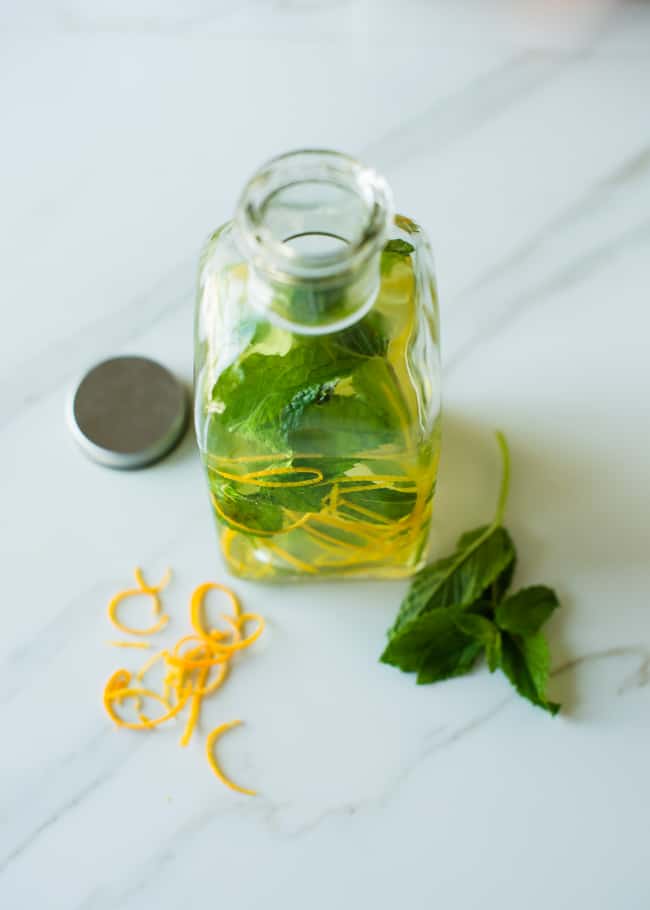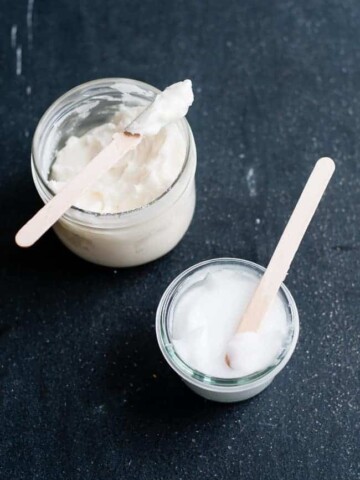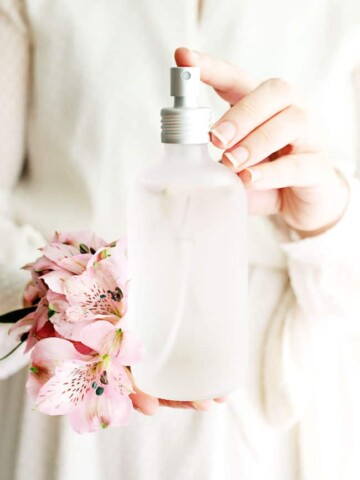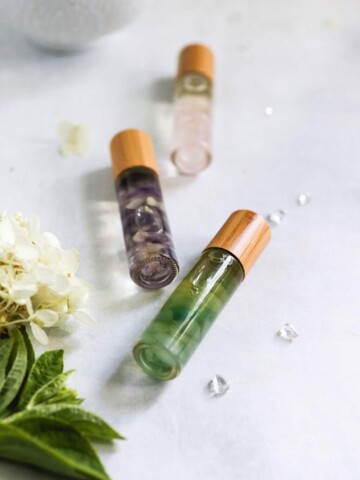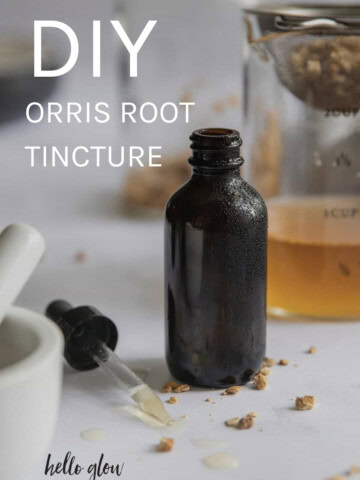We all like to smell good, but commercial perfumes are loaded with scary ingredients. Plus, they usually smell so strong that I wind up with a raging headache. Fortunately, it's super easy—and fun—to experiment with making your own perfume, and you can mix up this DIY botanical cologne from ingredients growing in your own backyard!

Making cologne from plants is a bit of a beauty science experiment. You can pick natural ingredients that will soothe and calm on a stressful day or stimulate and energize for the afternoon slump. Add a bit of this herb and a dash of that flower, then wait a few weeks and see what happens.
These homemade scents won't be as strong as commercial perfume (a good thing, if you ask me), but the smell will be more natural and you can customize it to your own preferences. A signature DIY perfume spray is super unique and perfect for adding a touch of sophistication.
Vanilla Rose Botanical Cologne
If you're looking for an easy way to make perfume from flowers, this recipe is a great place to start. The combination of herbs and vanilla creates a soft, subtle fragrance that's great for soothing anxiety and stress.
And because it uses dried flowers, you don't have to worry about finding fresh organic blooms—just head to the bulk bins at your local organic market to get everything you need.
As an added bonus, we're using a whole vanilla bean, which means this won't be as sweet and cloying as vanilla-based scents usually are. This DIY rose perfume is a classic combination that everyone will love!
Vanilla Rose Cologne Recipe
—Handful of fresh or dried organic rose petals
—Handful of fresh or dried organic lavender
—1 vanilla bean
—Vodka
If you love vanilla, try this sandalwood vanilla essential oil perfume!
Instructions
Combine the flowers and vanilla in a clean, dry glass mason jar. Pour in enough vodka to thoroughly cover the dried flowers so there's at least 1 inch of vodka at the bottom. And as the flowers absorb the alcohol, they will sink.
Put the lid on and give your botanical cologne a shake every 1–2 days. Let sit for at least 2 weeks (4–6 is better), then strain the flowers.
Pour the resulting liquid into a bottle; a spritz top works best. Don't worry if the liquid changes color a little bit—it's a totally natural part of the process.
Orange Mint Botanical Cologne
The smell of citrus always perks me up and helps tame my anxiety, which is one of the reasons I wanted to make citrus cologne. Not to mention, I have a huge wild mint patch, so I combined fresh mint leaves with orange for this happy scent.
Orange essential oil blends well with many other essential oils, which means you can customize your perfume to suit your personal preferences. So, use whatever is growing in your garden—fresh basil would be lovely as well!
Citrus Mint Cologne Recipe
—Peel from 1 orange, white pith removed
—Handful of fresh mint leaves
—Sweet orange essential oil
—Peppermint essential oil
—Vodka
Instructions
Combine the orange peel and mint leaves in a clean, dry glass mason jar. You can bruise the mint a little bit to ensure that it infuses in the vodka well for a stronger scent.
Pour in vodka until there's 1 inch of liquid above the peel. Put the lid on, and give the jar a shake every so often. Let it sit for at least 2 weeks (4–6 is better), then strain out the peel and mint.
This botanical cologne doesn't have a very strong scent, so you can add 5 drops of sweet citrus and 1 drop of peppermint for each cup of cologne to give it a boost—or more if you want a stronger fragrance. Pour the resulting liquid into a bottle; a spritz top works best.
Tips for Making Your Own Cologne
Choosing scents for your homemade cologne can be a fun and creative process, but it can also be overwhelming with so many options available. Here are some tips to help you choose the right herbs and essential oils for your homemade fragrance:
Start with a theme or inspiration
Think about what you want your perfume to evoke. Do you want it to be fresh and invigorating or warm and comforting? Consider what scents inspire you, such as the smell of the ocean or a favorite flower, and use that as a starting point.
Consider the top, middle, and base notes
A well-balanced perfume contains top, middle, and base notes, which create depth and complexity in the scent. Top notes are the first scents you smell and typically include citrus or florals.
Middle notes are the heart of the fragrance and include warm, spicy, or herbaceous scents. And base notes are its foundation, which typically includes deep, musky, or woody scents.
Experiment with blending
Once you have a few scents in mind, experiment with combining them in small amounts to see how they work together. If using essential oils, start with equal parts of each oil, and adjust the ratios as needed until you find a blend that smells good to you.
Consider the strength of the scent
Some herbs have a strong scent, while others are more subtle. Consider the strength of each herb or oil when blending them together to ensure the final scent is well-balanced and not overpowering.
Homemade Cologne FAQs
What's the difference between cologne and perfume?
While the terms are interchangeable, cologne and perfume aren't technically the same. Cologne typically has a lower fragrance-to-carrier ratio than perfume, which means it has a lighter scent and doesn't last as long.
What can I use instead of vodka in homemade cologne?
We recommend vodka because it's a relatively odorless alcohol, so it won't alter the smell of your cologne. But if you don't have vodka on hand, you can make cologne with grain alcohol, gin, or even witch hazel.
Can I make DIY perfume with vanilla extract?
Yes, it's possible to make homemade perfume with vanilla extract, but you may find that the scent doesn't last as long as when using vanilla essential oil or real vanilla bean.
After steeping the other botanical ingredients in alcohol for 4 to 5 weeks and straining out the solids, add ½ teaspoon of vanilla extract to your DIY cologne and give it a good shake. For a stronger scent, add an additional ½ to 1 teaspoon.
How can I make DIY perfume last longer?
It's true that homemade perfume doesn't hang around as long as its chemical-laden counterparts. But there are still a few things you can do to make your scent last longer.
For starters, fragrance adheres better to slightly damp skin, so apply homemade perfume right after a shower. Second, always spray it directly on pulse points, such as behind the ear, the wrists, and the crook of your elbow.
And last but not least, try layering different scents. Even if one wears off quickly, you may find that another scent has more staying power.
Next up: try making your own essential oil perfume. And if you have lots of flowers in your yard, why not make a botanical flower petal perfume?
Photos by Lindsey Rose Johnson
291



